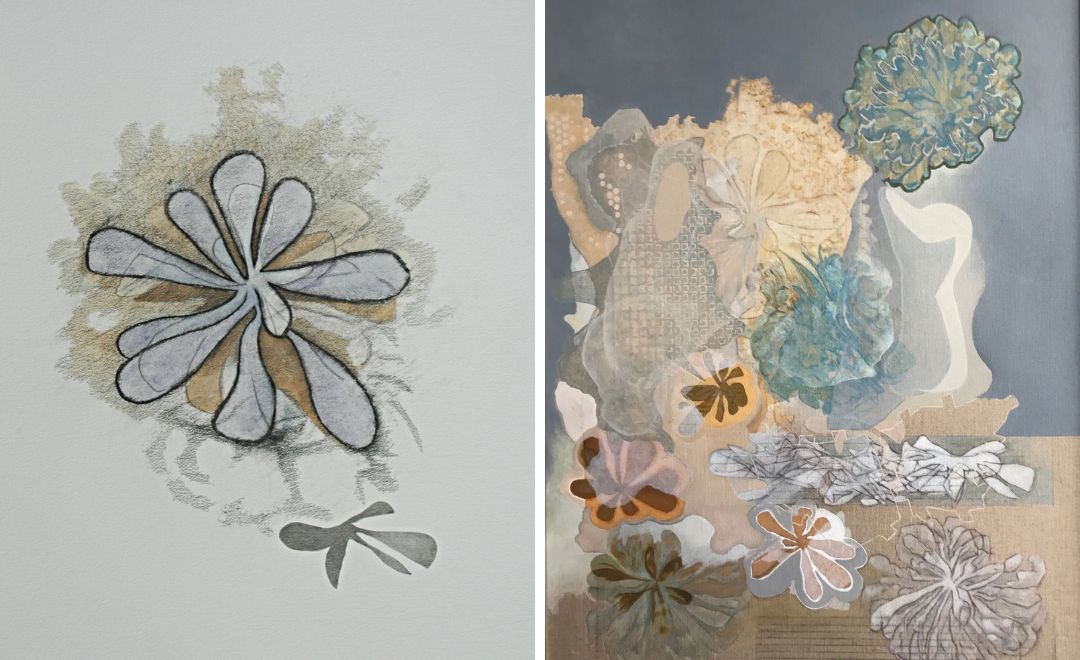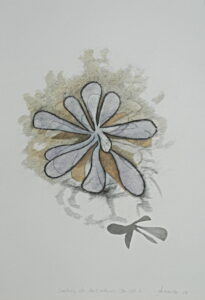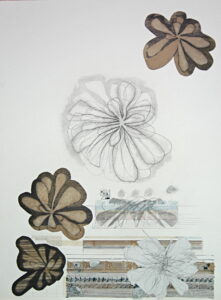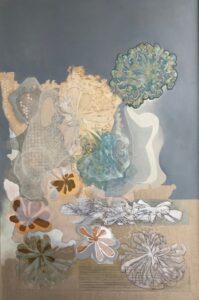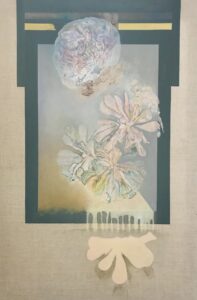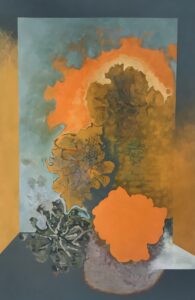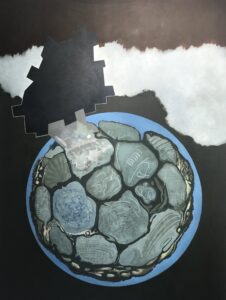Dr John McNorton is a freelance artist/educator/researcher and academic director of DRAWinternational, centre for drawing research in Caylus, France. He has been a cancer patient since 2003 and was an invited speaker and Patient Partner at the MASCC/AFSOS/ISOO 2024 Annual Meeting. He has kindly agreed to share this post as a follow-up to his talk.
‘My Meandering, Malignant, Melanoma’, or ‘My Dark Mole’.
The philosophical approach I take for my work is predominantly phenomenological. It has also informed and influenced my attitude and actions taken during my health challenges, from both a theoretical and practical perspective. The work presented is arranged chronologically, and reflects thoughts and attitudes experienced during this time.
Before
The first slide represents a single cell, not drawn from an actual cell, but from a succulent house plant. The drawing was modified to suggest a dancing cell, as a metaphor for its context, that is, what possibly could be. Then, the thought occured if cells can dance they must like music, so the sound of a cell became a conscious interest. These early drawings and paintings lead to many others. I later discovered there were even experiments in medical science which could locate and sonically attack certain cells without harm to its surrounding environment. Science and art shares so much. Towards the end of this series ‘my meandering malignant melanoma’ returned. My thoughts also changed and my work began to focus upon medical interventions, operations and scans. The heat of the experience can be seen in the latter works. A number of examinations followed leading to the discovery of further cancer cells in lymphatic glands and the lungs. A decision had to be made concerning possible chemotherapy and/or radium treatment. I decided to refuse both as I felt well and still energetic. However, I did declare an interest in the current research concerning immunotherapy, but at that time this was not available.
During
Matters changed, thankfully, the day I received a phone call from Professor Vincent Sibaud, at Oncopole Cancer Hospital, who asked if I was interested in taking part in the trials, which particularly focussed upon the treatment for pulmonary metastatic melanoma. How could I refuse and from that day onwards I have been forever thankful. The series of paintings (120x160cm) made during these months, reference and explore the feelings and thoughts about the immunotherapy infusions and my attempt to artistically construct schematically abstracted equivalents. This time the starting point was taken from a photograph of a cancer cell.
My Coma
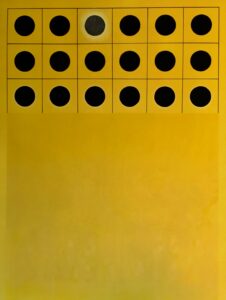
It was discovered, after rapid deterioration and emergency admission to Oncopole, that the immunotherapy treatment had eradicated my pancreas. As a result I am now a diabetes 1 patient. Immediately after the coma whilst in intensive care, I was captivated by a very prolonged after image, I made sketches and notes from the hospital bed. The painting included here is one of four and considers the naturalness of double and after image. This, mixed with my partially hidden imagery, slightly distorted to tease the viewer, in what is physically concrete and what is not, after a longer than normal gaze.
After

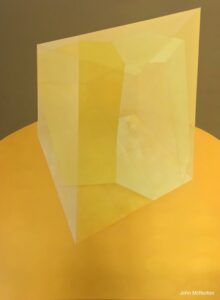
Settling down to life after treatment I discovered the relatively recent existence of scutoids, a geometrical or schematic solution to three-dimensional grouping of epithelia cells. I am referring to the cells found on the surface of the skin, but I think it exists everywhere. It has been proposed that scutoids make possible the minimisation of tissue energy stabilising its collective structure. It is thought that these, invisible to the eye, scutoids are one of nature’s solutions in achieving ‘epithelial bending’ and regeneration. How optimistic is that?
To contextualise, a place of departure to the place of arrival is an interval. We all so often zoom through time and space without consideration along the way, other than our arrival. Surely this can only leave to more of the same. Racing from A to B can become a corridor of emptiness without standing and staring. It can lead to little meaning just fact after fact in a space that ‘accelerates towards ‘deceased impoverishment’. (Byung-Chul Han, 2017). Deep down we all benefit from a journey that takes the opportunity to slow down, linger a while and make new connections. When we have those moments that go beyond the everyday thoughts and actions, we can realise something different, creativity itself in all its form. To observe, touch, smell and really ‘listen to the prevailing winds’ of experience can be a distraction from the self and is healing, but it does require disciplined action. In today’s digital world we witness a shortening of intervals, a HERE and a NOW. It takes us from one moment to the next without interval. This internet space is a discontinuous space. Our acceleration makes these temporal intervals disappear, they are devoid of bridging opportunities, therefore no connections are to be made. (Byung-Chul Han). Connections outside our own domain or comfort zone are vital to stimulate dynamic communication. Words alone are rarely enough for a deeper understanding. For the patient there are many things that can be done. Too numerous and complex to mention here. But to design varying interventions for willing patients, who may or may not recognise the full benefits of a time and a space for creative action seems a growing concern and positive focus for development. This does however, require personal responsibility from the patient. I welcome interaction between disciplines and always have done, after all, they are just social institutions.
Finally from ecologist and philosopher, David Abram, who has stated:
"Meaning sprouts in the very depths of the sensory world, in the heat of meaning, encounter, participation." (p.75)
David Abram, 1997 ‘The spell of the sensuous’, First Vintage Books.
Byung-Chul Han, 2017 ‘The scent of time’, Polity Books.
John McNorton M.Ed, PhD RCA(London)
Director
Drawinternational

